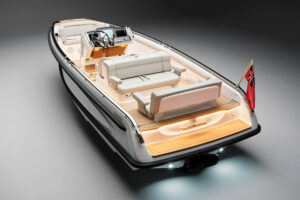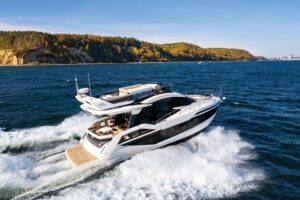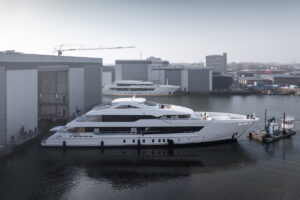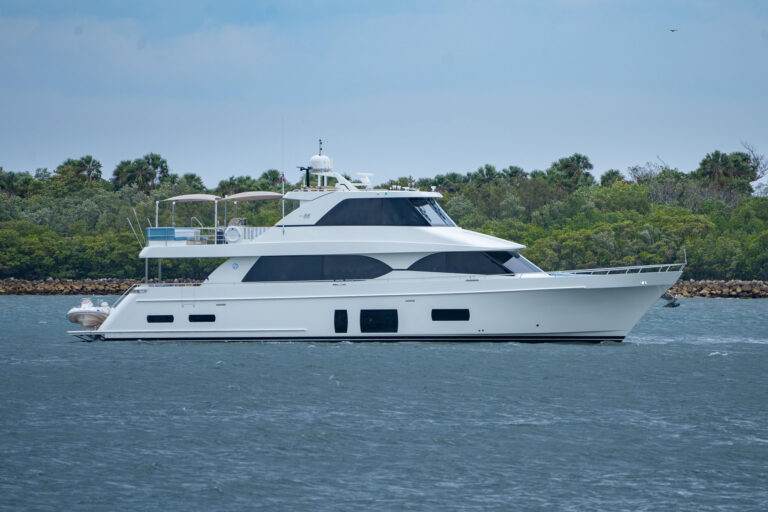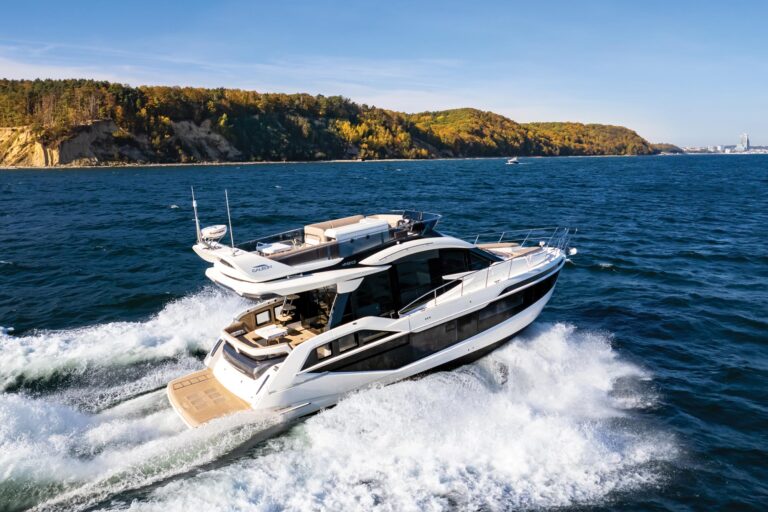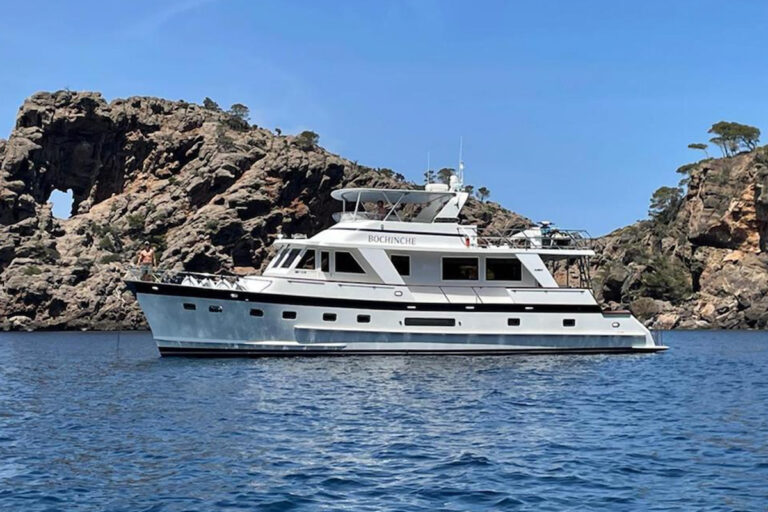The 80- to 90-foot motoryacht market is extremely competitive, a category that is difficult for builders because the length marks a transitional point between midrange yachts and megayachts. While boats in this range are far more complex and sophisticated than, say, typical 60-footers, many potential buyers expect systems, amenities and space fit for a megayacht.
Jellybean, the new Ocean Alexander 860, is designed to compete in this arena. She is the largest Ocean Alexander to date and the first in the builder’s Series 80 line. The impetus for creating the series was Jim McLaren of Orange Coast Yachts in Newport Beach, California, a leading dealer of Ocean Alexander yachts. During the past five years, McLaren watched clients move up and outgrow the builder’s existing line, and he brought his concerns to Taiwanese yacht builder Alexander Marine. Alexander Marine put McLaren in touch with naval architect Ed Monk, Jr., who for two decades has exclusively designed the traditional trawlers for which the builder is known. Monk’s reputation is for penning not only some of the finest boats to come out of Taiwan, but boats that rival North American and European builds in quality and value.
The team’s requirements for the new flagship included an 80- to 90-foot hull that would be flexible and efficient, with a wider-than-normal 22-foot beam to maximize interior volume. Megayacht-style features on hull number one were chosen based on the owner’s use of previous boats and his plans to cruise the rugged West Coast between Mexico and Alaska. These would include a large California deck raised above the cockpit and protected by the bridge overhang, and a cockpit that would allow big-game fishing and convenient entry to the water or tender. The flying bridge would be offered open or fully enclosed with a Portuguese bridge and wing stations for maneuvering. The boat would have a minimum of three guest staterooms (two with queen berths), and the master would be forward of the engineroom for maximum quiet and minimum motion. Other musts included separate crew quarters, entertaining space and walkaround decks protected by the bridge overhang.
With hydrodynamicist Ed Hagemann, Monk tank-tested the hull in up to 8-foot head seas. Monk also worked with structural engineer Tim Nolan to set construction specifications appropriate for the boat’s often-unforgiving destinations. The team used carbon-fiber stringers to stiffen the vacuum-bagged hull and deck, Klegecell foam sandwich above the waterline, and aircraft-grade aluminum framing, including 5-inch I-beams in the decks and hull sides.
Monk created multiple layouts to suit the preferences of different clients. Jellybean owner David Parker, a four-time Ocean Alexander owner, chose the split-stateroom layout, with after crew quarters, an enclosed bridge, and a fishing cockpit that extended the boat to 86 feet. In spite of weight-saving materials used in her construction, Jellybean is 180,000 pounds. Thanks to Monk’s slippery hull shape, however, she topped out at 20.3 knots during our test-with surprisingly low fuel consumption. Her performance reflects the efficiency Monk intended, and based on our test, the boat meets his standards for design and outfitting.
Jellybean reflects Alexander Marine’s willingness and ability to customize each Series 80 build. The California deck on Jellybean has a built-in settee with a Hi-Lo table, gas barbecue and an oversize refrigerator. Because the deck is at the same height as the saloon, the bulkhead can be moved during construction-forward for buyers in warm climates who want to maximize deck space, or aft for those in cooler climates who want an enlarged saloon.
Parker specified a “beach house-informal” interior finished in high-gloss teak. The saloon has two built-in settees and four loose, overstuffed chairs that can be arranged so guests can view the 42-inch, pop-up plasma television. A wet bar with refrigerator is forward, backed by a large mirror that is tilted slightly outward at the top to give seated guests an expansive reflected view aft.
The galley is forward on the saloon level. With an open flying bridge, the forward area of the house would have a lower helm station, but on Jellybean, Parker opted for an upper saloon for casual dining and lounging, with a banquette to starboard and a writing desk/office to port.
The megayacht-style full-beam master stateroom and VIP share a private stairwell opposite the galley, which leads to a small foyer below. The master has a king berth set off by a mirrored headboard and burled columns. A head with shower is to port, and a walk-in closet and vanity are to starboard. The VIP has a queen berth and a head with shower.
Guest cabins are forward, with stairs from the dining area. The starboard stateroom has twin berths, and the bow cabin has upper-and-lower singles. They share a head with shower. Space that could have been used for a fifth cabin was turned into a utility area, with an oversize freezer and full-size washer/dryer.
The enclosed pilothouse is designed with long-distance cruising in mind. The high instrument panel limits the view for anyone standing, but the three Stidd chairs adjust upward electrically. A settee with table converts to a double pilot berth and is raised, giving guests a good view. There is a wet bar with a sink and refrigerator, as well as a day head to port. With three doors, opening windows aft and overhead hatches, the pilothouse gets plenty of fresh air in pleasant weather. The Portuguese bridge gives the skipper a superb view when he’s docking (two of the four Kobelt control stations are on the wings; another is aft), and guests should be comfortable on the bench seating forward, behind the bridge coaming.
Other features include a watermaker that filters water twice before putting it in the tank, and cabin and pilothouse windows made from tempered safety glass. Tempered glass alone is far stronger than ordinary glass, while safety glass, which is used for car windows, does not create shards when broken. The combination increases strength and provides added safety in the event the glass does break.
Under way, the 860 is a delight. With bow and stern thrusters and a good view from the wing bridge, maneuvering is fingertip-easy. Jellybean‘s saloon and pilothouse were so quiet that my sound meter didn’t budge off the bottom of the scale (50 decibels, about the noise level in a private office), until we were cruising at 15 knots and 1800 rpm. Even at full throttle, levels in the pilothouse reached only 62 decibels, making this a very quiet yacht.
Equally remarkable was the low fuel consumption recorded during our test. When the yacht was cruising from Southern California into Mexico, skipper Mike Stinson found the “sweet spot.” At a comfortable displacement speed of 11.6 knots and with no generator running (a pair of 4,000-watt inverters can power a/c systems when the generators are off), fuel consumption for both engines was just 20 gallons per hour. Allowing for a 10 percent reserve, owners can expect a range of about 1,620 nautical miles at 12 knots.
The twin 1,460 hp MTU 12V2000 diesels pushed Jellybean to a top speed of 20.3 knots. At a power setting of 80 percent, her fast cruise was 18.4 knots. With her wide and seakindly hull, Jellybean was so stable in the mild seas that turning off the stabilizers hardly made a difference.
As the new flagship for Ocean Alexander, the 860 is a strong contender in the 80- to 90-foot marketplace. Built to high standards and beautifully finished, she is not to be missed.
Contact: Ocean Alexander Marine Yacht Sales, (206) 344-8566; oamys@aol.com; www.oceanalexander.net.

